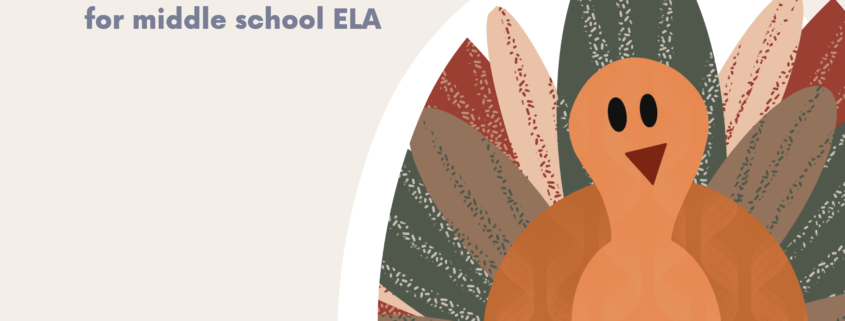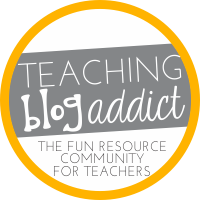Middle School ELA Thanksgiving Lessons
Middle School ELA Thanksgiving Lessons Your Students Will Love
There are so many fun middle school ELA Thanksgiving lessons that will make this time of year memorable. We would like to share some of our favorites with you.
Turkey Stories
One of my favorite Thanksgiving activities is an oldie. I think I did this when I was in middle school, but I’ve never forgotten it. Have your students write about Thanksgiving from the Turkey’s point of view. This makes an excellent activity on teaching point of view and on teaching perspective and how that perspective can create humor or suspense.
Write a Thanksgiving Story From the Turkey’s Perspective
One option is to have your students independently write a story telling about Thanksgiving from the perspective of the turkey. Before writing the story, have students do some brainstorming about the personality of their turkey and how things would be viewed through a turkey’s eyes. Most students have a lot of fun dreaming up a personality for their turkey. I always ask my students a few questions to get them started. Will your turkey be a country turkey or a city turkey? Will it be a shy turkey or the life of the party? As a class, brainstorm all different types of personalities that people can have, and then allow students to choose one for their turkey. This generates excitement and really brings the story to life.
Opportunity to Teach Dialogue and Dialect
You can spend time talking about how dialogue should match the personality of a character, and teach students about dialect. If your turkey is a valley girl, (that may date me. I don’t know if that term is in use anymore) you will want your turkey to say things that match it. So it may sound like, “I was like totally minding my own business when like this man wearing like leaves on his shirt like showed up in my part of the woods.”
You can even show some clips of movie characters to explain this. Think about the turtles on “Finding Nemo”. They have that surfer dude persona, and their dialogue matches it.
The other brainstorming you will want to do before students write the story is to really get into the mind of a turkey and to think about how things could be described. In the story “Rikki-tikki-tavi,” Nag and Nagina, the two cobras, don’t call a gun a gun. They call it a bang stick. Have students use this same strategy of naming something unknown for their turkey. What would they call a table if they didn’t know it was a table? Maybe a big log with legs? What would they call a human? A knife? An oven? This is a fun part of the process.
Once your brainstorming is done, your students will be ready to write a story. There are a few way this can be done as well.
- Let them write it individually and share them when they are done.
- Let them work with a partner.
- Let them write and pass the story. One group writes the beginning of the story and then passes it to the next group who continues it. This way, depending on how many groups you have in your classroom, there would be maybe four stories going at once that could be read afterward.
A Quick Write if You Are Short on Time
Now, if you don’t want to have students write a whole story, but you still want to do an activity where the students learn about perspective, you can have them do what we call a quick write. Have them write a short description of something that is a part of Thanksgiving from the perspective of the turkey and let the rest of the class see if they can guess what it is. For example, one student may describe an oven from a turkey’s point of view. Another student may describe pumpkin pie.
If you would like another idea on quick writes, this link will take you to our blog on strong verb paragraphs.
A Resource for You!
We have a free resource in our TPT store that has some printables that you can use for the Thanksgiving from the turkey’s point of view activity. This resource also has an option that you can use as a guided writing exercise. In this one, your students will fill in the blanks for the first paragraph of their story as they decide on a setting and then write as if they are the turkey and they hear someone creeping up on them. The questions will guide them in writing what happens next, and they will end up with a very suspenseful tale of their turkey. These stories can be written in one class period and can turn out pretty funny!
Thanksgiving Poetry
Acrostic poetry is another perfect middle school ELA Thanksgiving lesson. These are simple, but perfect for reflection. If you want to make it more meaningful, have your students write it about things that they are thankful for. I have even told my kids that it would be special if they could write one that could be read at their thanksgiving dinner. Some kids in the past have even written an acrostic poem prayer that could be read for their family.
T
H
A
N
K
F
U
L
A Reading Passage
If you’re looking for something to have on hand for a quiet class period around Thanksgiving time, or if you know you’re going to be absent, we have a cute Thanksgiving story called “Wishbone Valley”.
“Wishbone Valley” is a short story about a boy who faces a lot of trouble after running into the ghost of a Thanksgiving turkey. After reading the story, your students can answer our multiple choice comprehension questions or practice writing an objective summary. This resource is available in our TpT store.
Play a Thanksgiving Game!
We also play a Figurative language review game called “Watch Out for That Turkey.” It will keep your entire class engaged as you review the types of figurative language: simile, metaphor, idiom, personification, hyperbole, oxymoron.
This is a game of luck. There are twenty questions to review figurative language. Some questions ask for students to identify the definitions of figurative language, and others ask students to decide which type of figurative language is at use in a sentence.
After students answer a question, you will go over it using the answer key slides, explaining why the answer is right. Only after they have listened to the right answer and an explanation, will you allow them to choose a colored box on the slide. There are three colors to choose from per round/question. Those students who get the question wrong cannot choose a color for that round.
Behind each colored square is a number. Students earn the points on the card. Here’s the kicker, though; Turkeys erase all points earned so far. So if a student chooses a color with a turkey behind it, all points earned so far are wiped away for that student. This is what keeps the students excited and into the game. They never know when a turkey may be overturned. If you’d like to play that game, you can check out our TPT store!
We hope you enjoy these middle school ELA Thanksgiving lessons, and we hope you enjoy your Thanksgiving break with your family and friends!




